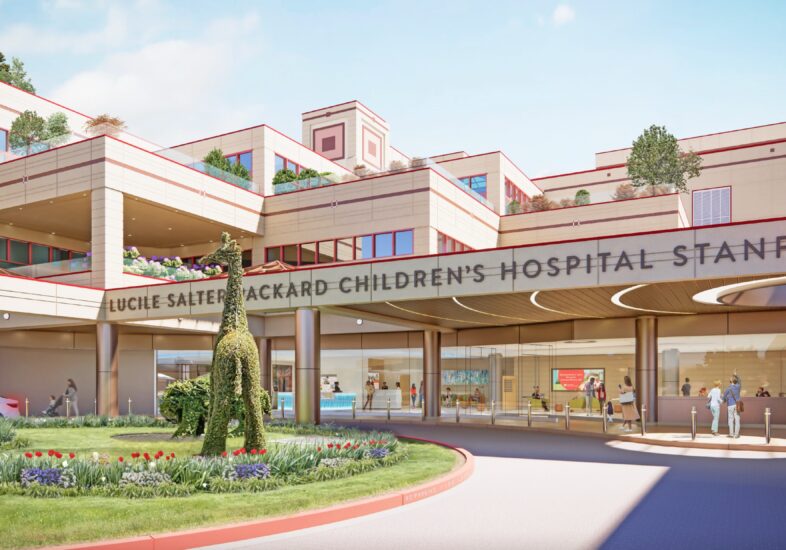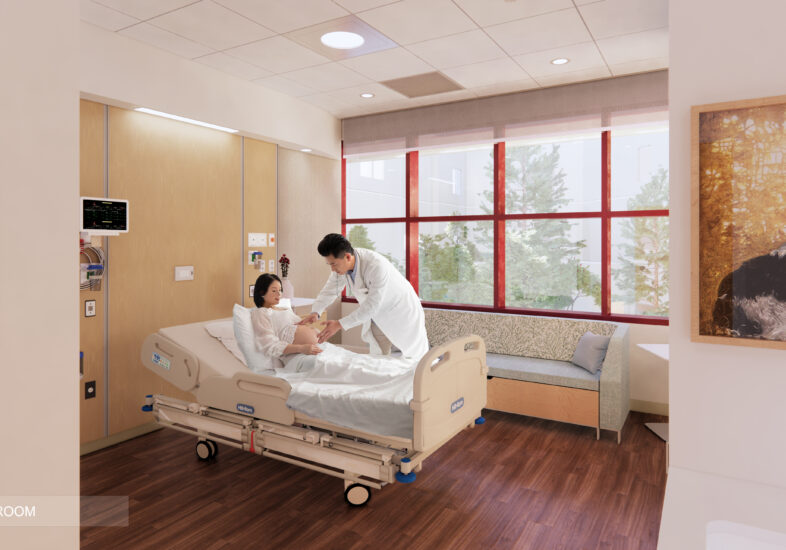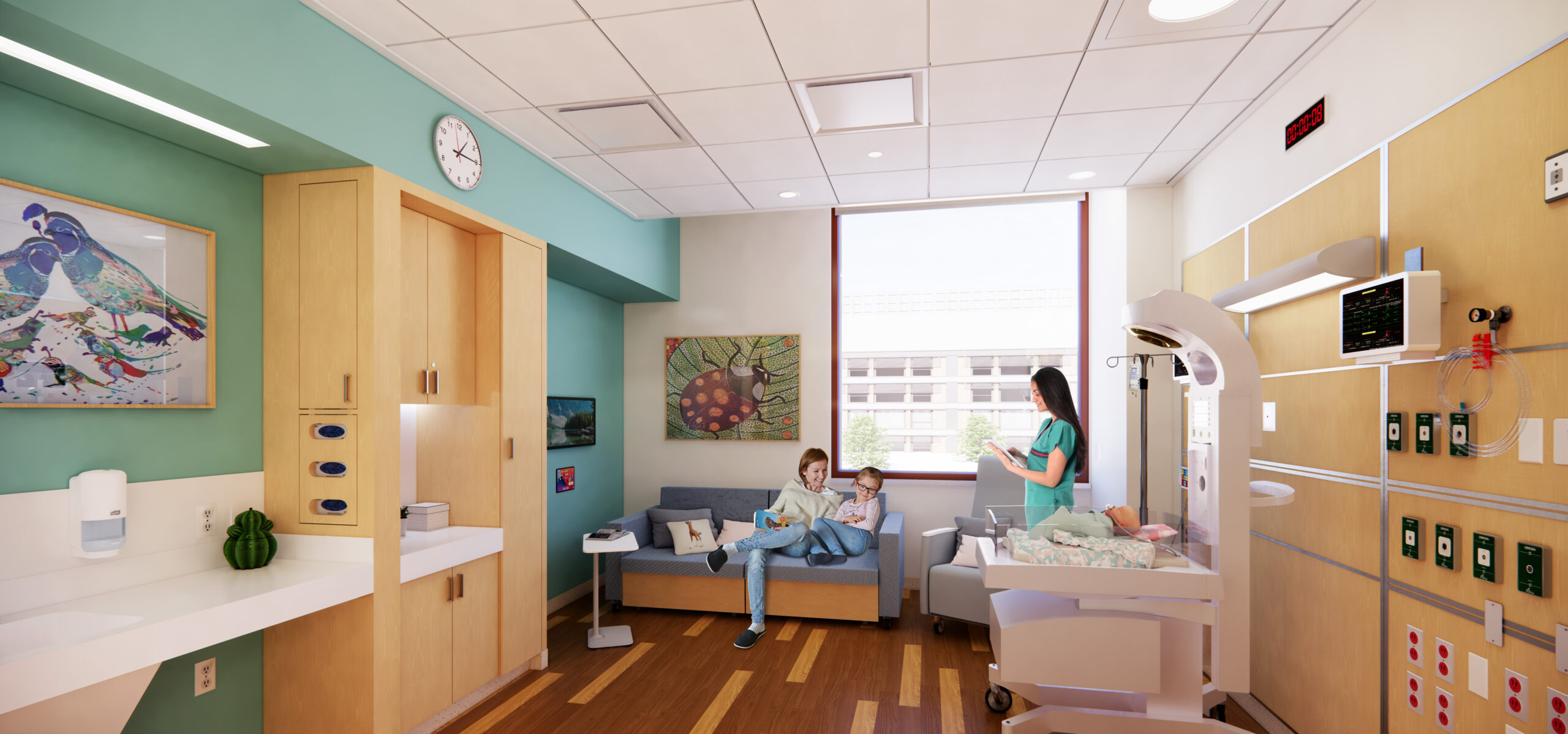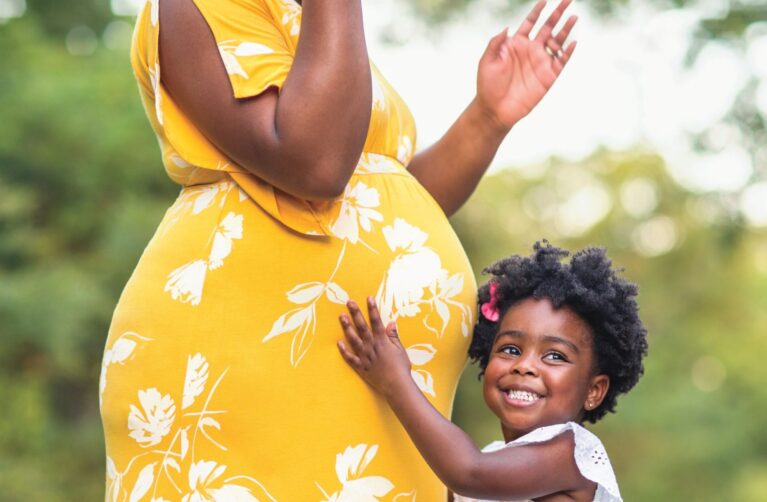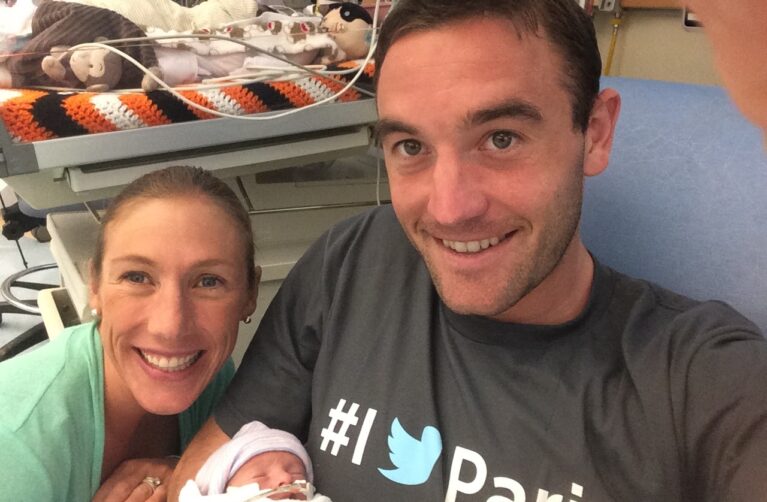Packard Children’s reimagined facility will offer next-level care for moms and babies.
“Anson is a super happy and curious little boy. He loves to be around people.” – Shirley, Anson’s mom
When her water broke just 24 weeks into her pregnancy, Shirley was distraught and confused. With her husband, Jason, by her side, she rushed from their Bay Area home to Lucile Packard Children’s Hospital Stanford. “We’d always planned to go to Stanford because we trusted the people—we knew the doctors were really talented,” Shirley says.
Shirley stayed in a room for high-risk moms in the maternity unit, where her care team tried to keep her baby in the womb for as long as possible. Nearly two years later, she vividly remembers the nurses who looked after her family during that time. “The first three nights, we had the same wonderful nurse checking in on us and calming us down,” she says. “And we had a day nurse whose style was very different—she was direct—but super helpful and reassuring.”
Confident in her care but worried that premature labor could begin at any moment, Shirley found it difficult to be in the regular maternity unit, surrounded by moms and their healthy newborns. “Hearing babies crying was pretty emotionally triggering,” she recalls of the six weeks she spent there.
Fortunately, an ambitious new project will transform Packard Children’s Hospital’s original facility, known as the West building, to better meet the needs of expectant, laboring, and new moms like Shirley, along with newborns who need specialized care. One of the key enhancements is a dedicated antepartum unit with nine private rooms specifically for moms with high-risk pregnancies.
The building will also feature upgraded labor and delivery rooms, private neonatal intensive care unit (NICU) rooms, private postpartum maternity rooms, and three state-of-the-art C-section operating rooms. Increasing the size of the labor and delivery unit will allow for 20 percent more deliveries to better serve moms in our community.
“I’m so glad other families will have this space,” Shirley says. “When you’re in a situation like ours, the [physical environment] really makes a difference. You’re there day in and day out, and you need to feel comfortable. Especially for those families who have traveled to get to [Packard Children’s Hospital].” The reconfigured West building will also offer a better experience for parents and newborns following delivery. Fifty-one private postpartum rooms will have ample space for a mom and her partner to room with their baby, facilitating bonding at this crucial time. “When we first opened 30 years ago, the facility was cutting edge—but the infrastructure simply has not kept up with the modern and innovative care we provide today,” says Lance Prince, MD, the Philip Sunshine, MD, Professor of Neonatology and division chief for Neonatal and Developmental Medicine at the Stanford University School of Medicine. “We are thrilled we will have a new space to foster the lifesaving care that can be necessary for complex pregnancies and deliveries.”
The NICU, too, will be completely reimagined to have private rooms rather than the current open-style unit, which is usually full with parents, babies, and staff, and has no accommodations for parents to stay overnight with their child.
“It’s important to make a NICU as ‘womb-like’ as possible—after all, that’s where these premature babies should be, in the womb!” says Prince, who also serves as co-director of the Johnson Center for Pregnancy and Newborn Services. The change to private rooms, he notes, “will decrease the risk of infection for babies’ immature immune systems and cut out loud, jarring noises, like those from alarms and crowded spaces.”After being delivered by C-section at just 30 weeks, Shirley’s now-thriving toddler, Anson, spent 10 weeks in the NICU. “The care team was super attentive, andwe learned how to take care of Anson by watching them,” she remembers. “The U.S. News & World Report rankings actually came out while he was in the NICU, and it meant so much to me to know that he was at the best possible place.” Packard Children’s Hospital ranked among the top hospitals in the nation for neonatology in 2021-22.
Still, the cramped conditions made for a less-than ideal NICU experience, Shirley says. “I would have picked up my baby more, if not for concern that I was in the way.” And, she says, with more privacy she would have felt less self-conscious about breastfeeding, especially when her son was first learning to latch on. Statistics bear out the benefits of private rooms for new families, especially for NICU babies. In addition to lowering rates of mortality for these vulnerable little ones, benefits include shorter hospital stays, increased parental involvement, and better success with breastfeeding.
Pioneering Research
Beyond enhancing patient care, the transformed space will be a platform for research. Packard Children’s Hospital is already known for its life-saving innovations, which have influenced care for moms and babies statewide and beyond.
“There is so much potential on the horizon, and this world-class clinical space will help to unlock it.”
YASSER EL-SAYED, MD
“With the Dunlevie Maternal-Fetal Medicine Center for Discovery, Innovation and Clinical Impact, we are uniquely positioned to advance maternal-fetal science like never before,” says Yasser El-Sayed, MD, obstetrician-in-chief at Packard Children’s Hospital and co-director of the Johnson Center for Pregnancy and Newborn Services. “We care for the most medically and surgically complex pregnant women and are pioneering novel fetal therapies. There is so much potential on the horizon, and this world-class clinical space will help to unlock it.”
Another example is the work that the Prematurity Research Center does through two statewide outreach programs launched at Packard Children’s Hospital. “We have already successfully lowered the rate of C-sections among healthy moms throughout the state, and our initiatives are being used as a national model,” says David K. Stevenson, MD, Harold K. Faber Professor of Pediatrics; senior associate dean, Maternal and Child Health; and professor, by courtesy, of Obstetrics and Gynecology.
Stevenson cites current efforts to lower rates of preeclampsia and anemia, which impact African American women disproportionately, as well as work on a simple blood test that could predict preterm birth—a breakthrough that he calls a game changer. “This new facility will support our incredible research program, which drives discoveries that impact patient care around the globe,” Stevenson says. This ambitious construction project will take place in phases; new units will open to patients as they are completed, allowing the hospital to continue serving the community without interruption. Packard Children’s is a critical safety net for moms and babies in the community. Roughly 40 percent of the hospital’s patients rely on public insurance.
The NICU will be one of the earliest areas to start construction, with the hope that families will occupy the first new units beginning in 2024. Soon after, high-risk moms will have their own private space. By decade’s end, labor and delivery, a new postpartum maternity unit, and the fourth and final NICU will complete the space transformation.
The Role of Philanthropy
The ambitious project would be impossible without philanthropic support from community members. To date, the Dunlevie family and the David and Lucile Packard Foundation have made significant early gifts to support the project.
Additional donor support at every level has the power to bring the project to the finish line, delivering the outstanding facilities, care, and health outcomes that all mothers and babies deserve.
“I know how much these spaces will mean to moms and families,” Shirley says. “I’m encouraged to figure out ways that I can give back, too—maybe not large sums like these, but little by little over time.”
How You Can Help
Join us in reimagining our home for mothers and babies!
Gifts of all sizes will help to bring these world-class facilities to life.
For more information about naming opportunities, contact Sarah Collins at Sarah.Collins@lpfch.org or (650) 736-1243.

